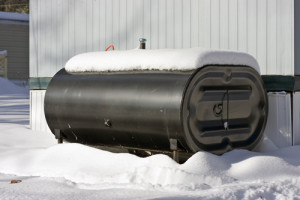Homeowners Urged to Check for Home-heating Oil Leaks

Every year, the New York State Department of Environmental Conservation deals with hundreds of fuel oil spills from home heating tanks.
The New York State Department of Environmental Conservation (DEC) is asking homeowners who use fuel oil to heat their homes to check their systems for leaks as we move into the winter season. According to state data, more than 2 million homes in New York State are heated by fuel oil.
Every year, the DEC deals with hundreds of fuel oil spills from home heating tanks. Spills can result in contamination of groundwater, wells, soil and even basements. A few of the more common causes of spills are faulty fuel lines, line connections, failing storage tanks, collapsing tank supports or legs, and oil delivery overflows.
An annual inspection of the fuel tank and fuel lines can help prevent costly spills and contamination. If a spill does occur, the cleanup can be extremely expensive and in many cases those cost will not be covered by a standard homeowners insurance policy.
Heating oil spills can have serious repercussions for the homeowner. While regulations vary by state, in most states if the discharge enters or threatens to enter the environment the leak or spill can be subject to state or federal oil spill laws. Even a spill that occurs in a basement can be considered a threat to the environment if the oil finds its way into the soil through a floor drain or a crack in a concrete floor.
In the event of a spill, the leak must be stopped, the area where the spill occurred must be evaluated and then a cleanup must take place. In many cases those costs will fall to the homeowner. The longer a leak or spill is allowed to sit without being repaired or cleaned up the more expensive the eventual cleanup will be.
These costs can be significant with industry experts stating that a typical evaluation and cleanup of a spill that affects groundwater can easily exceed $250,000 and even climb all the way up to $1 million.
Heating Oil and Homeowners Insurance
While it varies by insurance company and state regulations, most standard homeowners insurance policies will not cover the cost of an oil spill. Most policies contained an “absolute pollution clause” which denies coverage in the event of an oil spill.
While homeowners insurance policies will not provide coverage for oil spills that are due to the lack of maintenance by the homeowner they may provide coverage if somebody breaks into your home and opens a valve on the tank causing a spill.
Some states, such as Massachusetts have passed legislation that requires insurance companies to cover the cost of home heating oil spills, provided that the homeowner meets specific requirements.
As an example, homeowners in Massachusetts with one or more fuel supply lines that come in direct contact with concrete earth or other floor services must enclose that supply line with a continuous nonmetallic sleeve and install an oil safety valve at the tank.
Another issue that concerns homeowners is third-party liability. If your spill is found to be the cause of damage to a neighbor’s property or groundwater, you can be on the hook for all cleanup costs. These costs can quickly spiral out of control and will often exceed the policy limits of most homeowner policies. It is often a good idea to consider an umbrella policy, which would help cover expenses above your homeowner policy limits.
Heating Oil System Checklist
The DEC has provided a checklist for residents to use when inspecting their storage tanks and fuel delivery systems. It is highly recommended that homeowners who use heating oil inspect their systems every year.
Above Ground Heating Fuel Oils Storage Tank Checklist
If any of the following conditions are found, the fuel system should be inspected by a professional and repaired immediately.
- Bent, rusty, or wobbly tank legs or a tank located on an unstable foundation.
- Signs of rust, weeps, wet spots, or excessive dents on the tank’s surface.
- Drips or any signs of leaks around the oil filter or valves.
- Fuel oil lines not covered in a protective casing – even if under concrete.
- Overhanging eaves where snow and ice could fall onto the tank.
- Stains on ground or strong oil odor around the tank location.
- Browning, dying or loss of vegetation around the tank location.
- Silent overfill whistle while tank is being filled – ask fuel delivery person.
- Clogged or restricted tank vent due to snow, ice or insect nests.
- Signs of spills around fill pipe or vent pipe.
- Improperly sized vent pipes – ask fuel delivery person.
- Cracked, stuck or frozen fuel level gauge or signs of fuel around it.
- Underground Heating Fuel Oils Storage Tank Checklist
If you have any concerns or questions about the status of your policy please contact us at HomeInsuranceKing.com.
